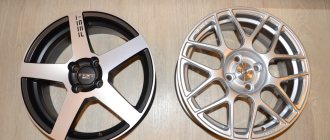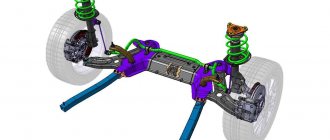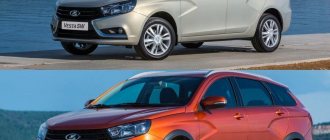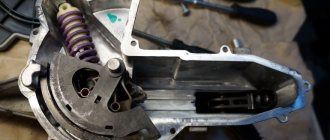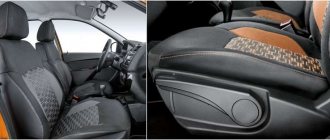The success of the Lada Vesta in the market as a whole, and especially in comparison with previous AvtoVAZ models, could not but receive its logical continuation. In 2021, in the fall, Lada Vesta SW and Lada Vesta SW Cross went on sale. Vesta has already managed to make a name for itself, so there was a sense of excitement over the new products, and the start of sales was successful, however, when comparing the SW cross and the regular LadaVesta station wagon, it is not immediately clear why these are different cars at all? In fact, Lada Vesta and Lada Vesta Cross have differences in many parameters, we will try to highlight the main ones.
Comparison of bodies and wheelbases
Cars from the new AvtoVAZ model line both have decent dimensions, but there are still differences between the Lada Vesta SW Cross and its sister: So, the Cross is 20 mm higher: 1532 mm versus 1512, 21 mm wider: 1785 mm and 1764 mm, longer by 14 mm: 4424 mm and 4410 mm, Vesta SW cross has a 14 mm larger track. The wheelbase of the cars is the same, but the wheels themselves are different. Drivers of a regular Lada SW will have to be content with 15 and 16-inch wheels; the SW cross has 17-inch wheels. In general, Cross is larger in all respects.
Passability: 3:3
Vesta SW is not a bulge: 178 mm under the steel protection of the power unit is a normal option for Russia. And Cross is even more versatile. Under his even belly he has as much as 203 mm. The VAZ team didn’t embellish it, the body was really raised to a new height - an impartial roulette confirmed it. For comparison, popular crossovers like the Kia Sportage, Volkswagen Tiguan or Ford Kuga have a real ground clearance of about 180 mm. But the Cross will not have all-wheel drive yet. And coupled with road tires Pirelli Cinturato P7 205/60 R17 (SW has Matador Elite 3 195/55 R16) these are the main restrictions on cross-country ability. But as long as there is enough grip and geometry, the Cross crawls forward. We convinced ourselves of this when the clumsy standard navigation took us onto a very rough dirt road, where, as a colleague recalled, we had recently tested a Mitsubishi Pajero Sport SUV. The raised Vesta slid down the slope, jumped over boulders, took a muddy ford and only stumbled on a wet rise, riddled with ruts. On the way back we had to push Cross a little up the hill, but the main thing was that we got out. The off-road exam has been passed, get a point in your piggy bank.
With the exception of the front bumper, the plastic body kit of the Cross is natural, unpainted. Approach and departure angles are approximately 1.5 degrees greater than the regular SW, despite the extended overhangs. Electronic assistants include imitation of cross-wheel locking and hill start assistant
Model design
The first glance at a book is always at its cover; you don’t judge the book by it, but you can judge the owner of the car with almost 100% confidence by its design. In their new models, VAZ maintains style. Still the same bias towards sports, which is not surprising, because SW stands for “SportWagon”, all the same stylish X-shaped patterns. But AvtoVAZ nevertheless made a difference between the Lada Vesta SW and the Lada Vesta SW Cross. In terms of body design, we are more impressed by the Vesta Cross, firstly, the color of the Lada Vesta SV Cross is “Mars”, in other words, metallic orange. But more significant is the black plastic body kit; this part protects the most vulnerable spot of the car from scratches, and subsequently, from rotting. A decorative exhaust tip makes the car more sporty and aggressive, while the regular Lada Vesta SW does not look so menacing and daring. Looking at the Vesta SW Cross, you can immediately see that it is for off-road use, which is not too different from what we call roads; its driver is a lover of active recreation in almost extreme places with his family or a group of friends. While the driver of the Vesta SW is also no stranger, but instead of off-road, he relies on any road, but the road, and his passion is not conquering hard-to-reach areas, but active recreation in the country and, of course, barbecues.
Package 2018
Take a closer look at the wheels of the Cross-station wagon - this is the first production Vesta with standard 17 inches! Tires of size 205/50 R17 will also be available on the Cross sedan, which will be released later, and in addition, they should also appear as an option on the regular Vesta.
The Lada will also have rear disc brakes - they are also clearly visible on each of the station wagons. Have you heard anything about problems with Vesta slowing down on standard “drums”? We, too. But the majority of Russian motorists are still confident that a car without “discs” at the rear cannot be ranked on a par with foreign cars. The engineers shrugged their shoulders, but AvtoVAZ marketers insisted on developing new brakes. However, rear “discs” are the lot of “advanced” versions.
It is easy to notice that the gas tank filler flap has lost its protruding “ear”: now it snaps and is locked with a central lock. The keyhole on the trunk door has disappeared - instead, a regular button finally appeared in the niche above the license plate. The antenna on the roof of station wagons has become a stylish fin (although the twig will remain on sedans), and the exhaust pipe of the Cross version now has a “double-barrel” nozzle, although on the basic version a thin tube still peeks out from under the bumper.
AvtoVAZ has not yet published photographs of the interior and trunk, but at the beginning of the year it was known that they were planning to introduce a box armrest between the front seats and a folding armrest for the rear sofa on Vesta. Over time, these improvements are expected on regular sedans. And the instrument panel with daytime lighting and the lamp above the rear sofa, on the contrary, have already migrated to all ordinary Vestas from export versions of the sedan.
Chassis and ground clearance
Ground clearance is an important detail for a car that is going to drive off-road; this is exactly what distinguishes the Vesta Cross station wagon from a regular SW. The next extremely important part of station wagons is the suspension. It is clear that new models should have good suspensions, this is indeed the case, the handling and smooth running of the cars are at a high level in comparison even with foreign cars, let alone previous VAZ models. But the features of the SW Cross consist of more advanced shock absorbers and springs, and added suspension settings make the car stiffer and more confident than its city brother.
Summarize
Going to a car dealership with full determination to buy a new representative of the Vesta family, the future owner will have to choose between 2 options:
- A station wagon with good driving performance, but a less striking appearance.
- A more expensive all-terrain station wagon with stunning design, a good level of equipment and minor technical miscalculations by engineers in driving characteristics.
From the point of view of a practical person, the first car is preferable to buy. Cheaper, drives better, and is not inferior to its brother in performance. However, the all-terrain station wagon is forgiven a lot for its amazingly beautiful design.
Salon
The first thing that catches your eye is that the Lada Vesta SW Cross has other colors of seats and inserts, namely, echoing the standard color of the car - “Mars”, that is, they are bright orange, making the car quite lively inside. But besides the color and “cross” inscriptions, the interior of the models is absolutely the same, but this does not mean that there is nothing to say about it. Adjusting the front seats allows you to find a truly comfortable position in the car, a comfortable armrest with a large volume for your items, convenient instruments from which the readings can be clearly read, curly inserts in the cabin continue the external design, you won’t forget that you are behind a Vesta. The back seat is simply wonderful: there is enough room for even three, there is more than enough legroom, high ceilings will be especially appreciated by all 180+ cm passengers, chargers, bags on the backs of the front seats, and most importantly - an armrest in the rear seat with cup holders, which generally makes us doubt whether we are sitting in a VAZ car?
Conclusions. Is it worth paying extra for an off-road option?
Despite the fact that the main parameters of the Vesta SV and SV Cross cars do not differ significantly, domestic consumers prefer to buy the Vesta Cross. According to AvtoVAZ, about 65% of Vesta car sales are made up of the off-road model. It is difficult to say what the reason for this choice is. Obviously, buyers are attracted by improved cross-country ability and high ground clearance, which is important for Russian road conditions.
The basis for buying a Cross is also its appearance, which looks more impressive thanks to large wheels, stylish body kits and slightly larger parameters of the car. In addition, original body colors are available for owners of the off-road version, which are not available in the regular sedan or station wagon version.
Engine performance and fuel consumption
The difference between Cross and just Vesta SW in engines and gearboxes lies only in the difference in their combinations. So, a regular station wagon has 16 valve engines of 1.8 and 1.6 liters with 122 and 106 horsepower, respectively. As well as manual and “robot” gearboxes on each of these engines. Vesta SW Cross does not have a “robot” on the 1.6 liter engine. The fuel consumption of a 1.6 liter engine per 100 km is from 7 to 7.3 liters, but the 1.8 liter engine is from 7.6 to 7.8. In general, reviews about the greater technical perfection and convenience of the 1.6 liter engine can be called close to the truth, so you should think twice before than to pay more money for additional volume.
Trunk
Fans of active recreation, family trips to the country, simply those who need to transport large volumes - that’s who are looking at station wagons, and the trunk is something that can radically change the decision of a potential buyer. First, we need to note the general things, namely: the double bottom, which noticeably increases the trunk space, AvtoVAZ’s elimination of the shabby folding second shelf in favor of a curtain, the presence of convenient pockets, nets, hooks, and compartments for all transportation options. And of course, general disadvantages: if you want to increase the volume of the already large trunk due to the rear seats, then you will be disappointed, they form a flat surface only with a false bottom, removing it, you will have to store things with a step. The second disadvantage is the high threshold, even with a false bottom; without it, it grows even more, becoming a decent obstacle for especially heavy things. Now let's move on to the differences.
Lada Vesta SW Cross comparison with Lada Vesta SW. The Cross station wagon has an external trunk release button! The designers focused on this part of the car and both Vesta SW are equipped with excellent trunks of 480 liters with a false floor, 575 without it and 875 liters with folded seats. AvtoVAZ gave the SW cars wonderful, spacious trunks in which you can fit any bags, thanks to the large volumes, and fragile things, securing them in additional compartments. The trunk is really not just big, but well-thought-out; for once, a convenient second shelf is an excellent opportunity to avoid putting bags on top of bags, risking damage to the contents. And the folded rear seats form a plane 170 cm long, which means that not only skis, but also a very tired traveler will fit there.
Price difference
Although both cars are station wagons, there are differences in price, and justified ones, so, when we compare the Lada Vesta SW Cross with a more urban version, we find a lot of differences in favor of the first, which, of course, affected the cost.
The base price of Vesta SW is 589,410 rubles, Vesta SW cross is 693,810 rubles. The difference is almost 100,000, for this the unique cross will have: a plastic body kit, “Mars” color, interior trim of the same color, a decorative exhaust pipe nozzle, wider ground clearance, a more advanced suspension and larger wheels, at least an inch. Is it worth 100,000 rubles? You decide. We will just note that in all Vesta AvtoVAZ paid great attention to safety, did not skimp on it, 4 airbags are already included in the most modest configuration, such concern for customers is very pleasant.
how does the Lada Vesta SW Cross differ from the regular SW station wagon - Ekaterinburg Auto News
Ten facts (two are not true) about the new Lada Vesta SW Cross
For the most thoughtful - a sheet of text below, for the most impatient - straight to the conclusions:
Higher, but not stronger
If we take the height according to the roof rails, then SW is 2 cm lower than the “Cross”. The ground clearance differs by 2.5 cm - 17.8 versus 20.3 for the SW Cross. Otherwise, the dimensions of the two station wagons also differ slightly: the SW Cross is a little longer, a little wider, all this difference goes into the body kit with which the “Cross” body is carefully wrapped.
If the difference in ground clearance affects the geometric cross-country ability, it is only in those places where it is generally sinful to drive passenger cars. If we take moderately compacted primers, then the Vesta SW can drive in the same places as the Cross.
Both station wagons have their own signature body color: the Cross has a fiery red “Mars”, the SW has a gray-beige metallic nicknamed “Carthage”, which, as you know, should be destroyed. For metallic you will have to pay an additional 12,000, but for exclusive - another 50% more - 18,000.
While the exterior dimensions differ, the interior space of both station wagons is identical. Therefore, passengers will be equally comfortable both in SW and in Cross.
| The upholstery is gray by default; for the Cross there are red inserts to choose from. Expensive versions come with heated rear seats and a USB port. It is most comfortable to sit behind a driver who is 175–180 cm tall: the legs are even slightly extended. Neither Solaris nor Rio provide such space. But in “Rapid” there is still more space. |
When measured to the shelf, there are 480 liters of usable volume - but this does not take into account the tray and raised floor, which consume 15 liters.
It turns out strange: the trunk is in fact the same as the sedan's. The only advantage is the height of the loads that can be transported: from floor to ceiling there is about 0.6–0.7 m.
The organization of space, of course, differs from the sedan: Vesta SW / Cross has two floor level options inside, 14 points for securing luggage nets, a belt for securing a canister with anti-freeze and two niches for various small items. If you remove all this, you can even fit a couple of small bicycles when folded.
And some more boring numbers: payload up to 475 kg, another 50 kg can be taken by roof rails.
| It is impossible not to note the convenient door handles on the trunk lid: this solution is much more convenient than any straps that we are used to. At the same time, the door is quite heavy, it takes a lot of effort. |
The range of power units for SW / SW Cross is the same, which means the problems are the same. The 1.8-liter engine is not enough either on the highway, or on serpentine roads, or on dirt roads: after an extremely stunted start, you still expect it to blossom at four thousand, but when these tachometer values are reached, the engine still roars more than it is lucky.
Here you can make two discounts at once: firstly, the engines are untested (800 km each), and secondly, it was in the mountains. But, on the one hand, I also received the test 1.6-liter Solaris from Rio untested, but they were driven much more vigorously; on the other hand, Krasnaya Polyana is not so high above sea level that the engine suffers from a lack of oxygen-poor air.
In terms of its traction capabilities, the VAZ 1.8-liter (122 hp) is somewhere between the Rapid 1.6 liter (110 hp) and the Rio 1.6 (123 hp). And he is still closer to the first: also strained - in second gear turned up - he drives up the mountain, and also - with a prayer on his lips - he goes out to overtake. At the same time, he eats like crazy: the average suburban consumption after two days of driving fluctuated between 10 and 13 liters per 100 km. Again, you can make a discount for being untested, but aren’t there too many discounts for one unit?
Higher, but more aerobatic
The most noticeable difference between the Lada Vesta SW and SW Cross is on the move. What seems sloppy and half-finished in an ordinary five-door car, in the Cross blossoms and turns into its strongest advantages. Take the mechanics: the SW Cross has clear, unambiguous shifts, but in the regular SW I missed II and III. Here it is time to remember that AvtoVAZ still has a wide tolerance range, and it is difficult to find two identical conveyor vehicles. Be that as it may, in terms of clarity and unambiguity of switching, the Cross is far ahead of the SW.
But the most radical difference is in the suspension settings. In those places where SW fell on its side, Cross continues to stand as a monolith. Where the SW's shock absorbers begin to tap due to the abundance of holes and stones, the Cross's suspension is silent. Where the SW compresses and picks up suspension travel, the Cross wobbles only slightly.
In other words, the Lada Vesta Cross is simply radically different on the move, even despite the heavier and low-profile 17-inch wheels. SW Cross has different springs and shock absorbers, the work of which is simply superbly calibrated. The “Cross” is stable on straight lines, stable in high-speed turns, fits perfectly into a series of turns of mountain serpentines, and most importantly, it can handle any surface. And he even knows how to land without failure after jumping on sudden springboards:
But in absentia I was expecting something completely different: the glamorous 17-inch Cross seemed like a city option, but life is a damn paradoxical thing, and now 205/50 R17 on the ground with sharp stones feels more comfortable than 195/55 R16. The only thing that the two station wagons have in common is the vibrations and shocks that go through the steering wheel: there are a lot of them, but I would like less.
In general, if I were choosing a Vesta for myself, it would be a SW Cross with a 1.6-liter engine (I wouldn’t pay extra for 1.8 liters), with a manual transmission, in Luxe/Multimedia performance and color "Mars". For 779,900 there will be front and side airbags, fog lights, climate control, a navigator (brake, by the way) and a rear view camera (with moving markings).
In my opinion, this is an absolutely fiery proposal, because a similarly packaged Rapid will cost 200 thousand more, and it is difficult to find other analogues here - Vesta Cross plays, in fact, in an uncompetitive field: Solaris/Rio do not have any five-door versions at all, or other station wagons There is no B-class expected in our market, except, perhaps, Largus, but it has a completely different audience.
Transmission
The gearbox in the new Vesta SW is of two types: “robot” and mechanical, and in the crossover with a 1.6 liter engine there will be no “robot”. Let's start with the mechanics. Here we must pay tribute, the reworking of the gears of old models and foreign parts did their job, changing gears is easy and pleasant. But what about the "robot"? Is it really so good that they don’t even put it on a smaller cross-country engine in order to provoke the purchase of a larger one? Rather, on the contrary, the VAZ robot is very far from ideal, it sucks all the pleasure that a manual transmission can provide, our condolences to all those who don’t like it, of course, this is not a detail that should scare you away from the car, but Vest’s mechanics are really nice .

